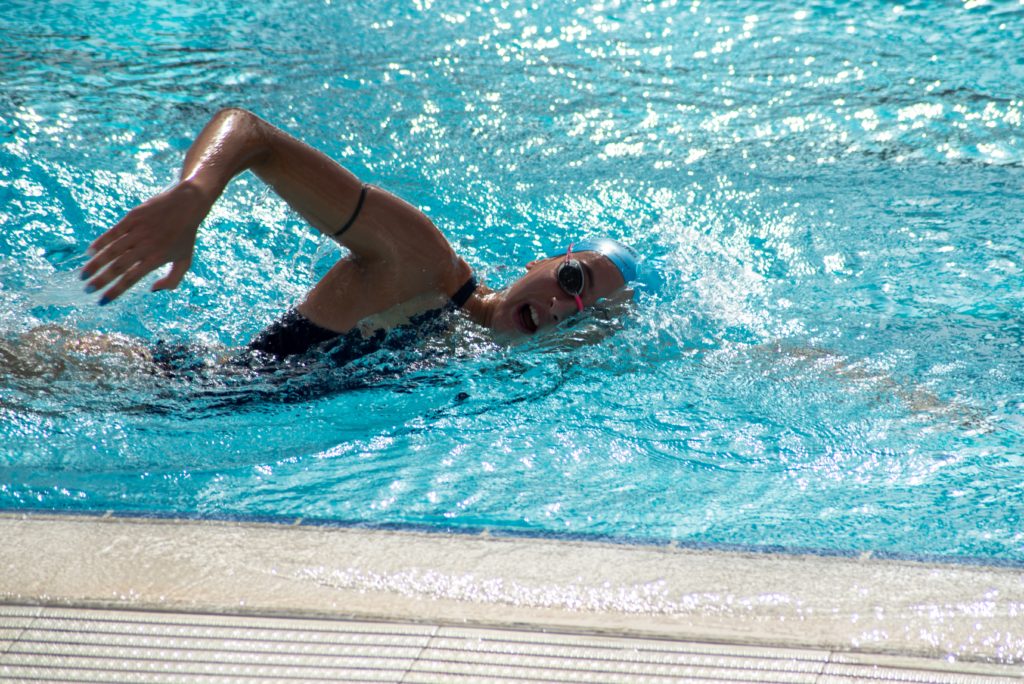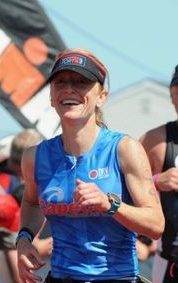ABCDs of Swimming

Many triathletes (including me) learn to *really* swim later in life, which can make swimming one of the hardest disciplines to master. Sometimes a session at the pool can become a little overwhelming because it seems like there are so many things to think about when you swim. The trick to improving in the swim is to focus on only a couple of things at a time when you go to the pool, so you don’t become frustrated. So let’s break it down into the ABCDs of swimming. These are for pool swimming and open water swimming is coming soon!
ABCDs of Swimming
A – Attitude
Although swimming is all about technique, one of the most important things you need to focus on is your attitude toward swimming. I will admit that I am guilty of saying things like, I’m so slow or I’m not a good swimmer. However, as we know, the body achieves what the mind believes. So if you don’t BELIEVE that you are a good swimmer, then your body won’t believe it either. Here are some ways to combat the negativity:
Mantras: I have mantras that help me positively connect my mind to my body. Saying things like “Long, strong, smooth, fast” or “Reach and rotate” or even something similar “I am powerful” can work wonders.
The word YET: Add “yet” to the end of your thoughts. For example, “I can’t master the catch…YET.” or “I can’t get below a 2:00/100 YET.” This implies progress, not perfection.
Drop the tech: Swim without a watch. For most swims, pace doesn’t matter. We spend much of the time working on technique and endurance and if we are worried about how fast we are swimming, that can affect confidence. (If my coach is reading this, he is laughing because I myself have trouble following this!)
B – Body Position
Body position is a simple phrase for such a complicated part of swimming. From your head to your toes, position matters in the water. There are so many analogies for body position, but I like to think of my body on a metal pole and I am slightly rotating side to side on that pole and my body has a neutral spine and neck. Here are a few tips:
Head- If your head is too high or too low, you will have more resistance in the water. Try to look down at the bottom of the pool. Your neck and head should be in a neutral position. You should not lift your head or look up in front of you. When you turn your head to breathe, it should be a gentle movement to the left or right, like your cheek is on a pillow. Some people like to think about having only one goggle out of the water.
Hips- Once you get the right head position, your hips will naturally lift up. You want your butt to be right above the water and your body as horizontal as possible. But don’t push your butt up, instead slightly push your hips down, with a slight arch in your back. You also don’t want to over rotate your hips as that will cause drag.
Legs- The kick isn’t really used for propulsion for triathletes as much as it’s used for balancing out your pull and helping the core stay strong. You don’t want to overkick or underkick; it’s a gentle flow, coming from the hips and your feet only move about 12 inches.
C – Catch
Ahhh the elusive catch. It’s 20% of your stroke, but gives you 80% of your power. The good news is there are a lot of drills out there to help with your catch. The challenge is getting your mind to relay to your body what you want it to do. The catch consists of:
- Hand entry into the water.
- The reach in front of you
- The start of your pull.
I like to think of it this way: “Fingers below wrist, wrist below elbow, elbow below shoulders.” You often hear about the “high elbow catch” but that phrase can be deceiving because people think your elbow needs to be near the surface of the water, but in reality, you just want an EVF (Early Vertical Forearm) and not a dropped elbow. There are lots of videos out there to help guide you, but getting someone to film you underwater can really help with improving your catch, so you can see what you are really doing (instead of what you think you are doing).
D – Drills
Drills are one of the best ways to work on your form. I like to drill for 1-2 lengths, then swim for 1-2 lengths, then drill, then swim. Here are three of my favorites:
- Doggy paddle: This helps work on the catch and pull. Start by floating on your chest. Then reach your arms forward, with your palms facing down. You can flutter kick with or without fins for this. Keep your forehead and eyes above the water. Then, move each hand forward and downward, then backward and upward, using circular movements. And yep, you are basically just swimming like a puppy!
- Catch up: This drill is basically one arm freestyle. It helps to slow down your stroke so you can work on breathing, being smooth in the water, and catching and pulling without dropping your elbow. I like to use fins for this one. With one arm extended (or on top of a kickboard), enter your other arm into the water and pull through. Really think about fingertips below elbow and elbow below shoulder and pulling toward the back of the pool and then finishing your stroke.
- 6-1-6: This drill is a bit more effective than catch up for working on body rotation, so it’s a good follow up. Use fins for this one. Rotate on your side with the lower arm out and top arm by your side. Look down while you kick for 6 kicks. Your nose should be close to your armpit. The extended arm is a little below the surface of the water and your elbow is a little higher than your wrist and your wrist is a bit higher than your hand. After 6 kicks, bring the top arm around until it catches up to the lead arm and then use that lead arm to stroke through the water and switch sides. 6 kick/ 1 stroke/ 6 kick.
Swimming can be one of the hardest disciplines to master, especially if you don’t come from a swimming background. These ABCDs of swimming will get you started and help set you up for success at your next triathlon. As Dory said to Marlin, JUST KEEP SWIMMING!

Amy Woods is a triathlete, Level 1 USAT Coach and fitness instructor who lives in Cape Cod, MA, with her husband, two teenage children, a poodle, and an old gray cat. She was a classroom teacher for 22 years and recently left the classroom to focus more on her family and her passion for all things fitness.
Amy teaches indoor cycling and strength classes in-person and virtually. She recently launched her own app (Amy Woods Fitness) and an on-demand video workout library, featuring everything from cycling and strength to yoga and barre. It’s a one-stop shop for fitness and includes other local instructors.
When Amy is not in the studio, you can probably find her swimming, biking, and running. She is an Ironman All World Athlete, a Boston Marathon qualifier, and part of the I Race Like A Girl team and her local Cape Cod Triathlon team.








